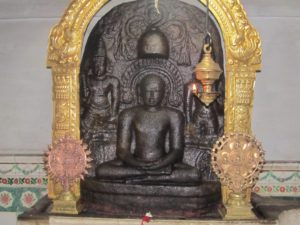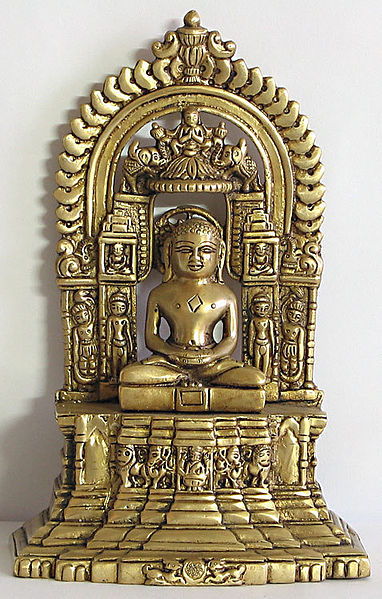India is a country with diverse castes and cultures and one of them is Jainism. Jain dharma is the oldest religion and pays deep emphasis on non-violence thereby showing the path to attain salvation or moksha. The famous quote of Jain dharma is “Ahimsa Parmo Dharma” which tells that non- violence is the prime religion and the pious or noble act of an individual.
Jainism or jain religion is followed by two sects of people. One is Degamber and the other Shwetamber and they worship God Mahavir who is the last or 24th Tirthankar of Jainism. Tirthankar is a human being who achieves the enlightenment and who has overcome the senses like anger, deceit, lust or desire, etc. Degamber is the those who worship idols of tirthankar without clothes and their monks or muni also discard wearing clothes. Swetamber is those whose saint or muni wear white clothes and they adorn their idol of tirthankar with white clothes. Although there are differences in their beliefs and rituals the common thing is that both sects follow the teachings of Lord mahavir from the heart and dedicate their time in meditation or puja of Tirthankar by regularly visiting temples. There are five ethics of Jainism which every individual should practice to become a true jain and moreover a true human being: Ahimsa (non-violence), Satya (the pursuit of truth), Asteya (non-stealing and honesty), Aparigraha (non-possession and non-attachment) and Brahmacharya (celibacy).
Early Life of Lord Mahavir
Lord Mahavir was born in 599 bc or 615 BC in a place called Vaishali in Bihar. It is believed that it was on the thirteenth day of chaitra month ie around March or April that he took birth as the son of Sidhartha who was the Raja or king of Kundalpura, and Queen Trishala .
 Queen Trishala had 16 or 14 dreams as per different sect and these dreams when interpreted predicted that the son will not be a normal human being instead, he will become a Tirthankar and will spread his teachings all over the world. And as predicted Mahavira also known as Veera or Veer Prabhu or Vardhaman discarded all possessions and pleasures of life and lived as a hermit or saint. He achieved full control over his senses through meditation and his preaching Samayak darshan (right belief), Samyak Gyan (right knowledge) and Samyak charitra (right conduct) opened the path towards liberation or moksha. When a soul achieves moksha then it gets free from the unending cycle of birth and death and attains freedom.
Queen Trishala had 16 or 14 dreams as per different sect and these dreams when interpreted predicted that the son will not be a normal human being instead, he will become a Tirthankar and will spread his teachings all over the world. And as predicted Mahavira also known as Veera or Veer Prabhu or Vardhaman discarded all possessions and pleasures of life and lived as a hermit or saint. He achieved full control over his senses through meditation and his preaching Samayak darshan (right belief), Samyak Gyan (right knowledge) and Samyak charitra (right conduct) opened the path towards liberation or moksha. When a soul achieves moksha then it gets free from the unending cycle of birth and death and attains freedom.
This auspicious day when Lord Mahavira was born is celebrated as Mahavir Jayanti throughout the country by Jains with great enthusiasm. On this day , from dawn to dusk the devotees are indulged in praying and chanting religious thoughts , stories and shlokas. It is believed that the more you live piously and peacefully discarding all the temptations and violence the more you become closer to God. In Jain dharm , as the teaching of God Mahavira, it is thought best to lead a simple life by applying the principals and practices of nonviolence, truthfulness, humanity, peace, and kindness towards animals and all living creatures.
The ceremony takes place from the morning itself and continues till night. The “abhishek or kalash” ie pouring pure and clean water as a traditional bath to the deity of lord Mahavira.
Then early morning Prabhat feri ie morning procession takes place where all children, women, and men, participate equally and throughout the procession, they chant slogans of Lord Mahavira and songs of devotion. All devotees are generally dressed up in white or orange clothes. Kids are seen with flags in hand and boards of slogans. One of the Lord’s famous slogans is “Live and let Live”. During the procession, the devotees offer coconut and incense before God’s idol in a chariot. After this grand procession, the devotee with God’s chariot arrives at the temple for preaching and meditation.
Jain shrines and pilgrimages
On this day the devotees also visit various Jain shrines and pilgrimages like Pawapuri or Mahavirji in Rajasthan, Girnar or Palitana in Gujrat where the Tirthankars attained Nirvana ie their body died but their purified soul got liberated through self-realization and enlightenment. Here, the Temple is decorated with flags and lighting all over.
 Several events take place after the procession like small skits by kids portraying the life of Lord Mahavira or dance by female devotees. At various places, grand feasts take place at noon in which all vegetarian food without root vegetables are served.
Several events take place after the procession like small skits by kids portraying the life of Lord Mahavira or dance by female devotees. At various places, grand feasts take place at noon in which all vegetarian food without root vegetables are served.
Jains are very strict followers of vegetarianism and they follow it sincerely. Then in the evening: aarti ie lighting candles in front of the lord’s idol and singing of devotional songs takes place. All devotees get engrossed in the worship of Lord Mahavira. Several devotees also fast ie remaining hungry the whole day and performing puja or other religious activity.
Thus Jain festival is celebrated in a very peaceful and simple form by applying the practices, beliefs, and teachings of Lord Mahavir.






